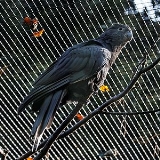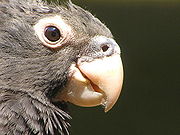
Greater Vasa Parrot
Encyclopedia

Vasa parrot
The vasa parrots are two species of parrot which are endemic to Madagascar and other islands in the western Indian Ocean.- Taxonomy :There are two species and several subspecies:Coracopsis, Wagler 1832...
, the other being the Lesser Vasa Parrot
Lesser Vasa Parrot
The Lesser Vasa Parrot or Black Parrot Coracopsis nigra is a black coloured parrot native to Comoros, Madagascar, Mayotte, and Seychelles. It is one of two species of vasa parrots, the other being the Greater Vasa Parrot C. vasa; although, the subspecies C. n...
C. nigra. The Greater vasa parrot can be found throughout Madagascar and the Comoros
Comoros
The Comoros , officially the Union of the Comoros is an archipelago island nation in the Indian Ocean, located off the eastern coast of Africa, on the northern end of the Mozambique Channel, between northeastern Mozambique and northwestern Madagascar...
. In Madagascar it is more common in portions of the Madagascar dry deciduous forests
Madagascar dry deciduous forests
The Madagascar dry deciduous forests represent a tropical dry forest ecoregion generally situated in the western part of Madagascar. The area has high numbers of endemic plant and animal species but has suffered large-scale clearance for agriculture...
, compared with the Lesser Vasa Parrot which is more common in the humid forests of the east coast. The Greater Vasa Parrot has a very unusual breeding biology and mating system. Females are 25% larger than males and are physically dominant. The species lives in loose polygynandrous groups wherein each female has at least 3-8 sexual partners. The males have re-evolved a phallus, one of the largest known in the avian world, and copulations can last up to 120 minutes. Copulations come in two varieties, short duration (1–3 seconds) and long duration (averaging 36 minutes), with the latter involving a copulatory tie. During brooding and chick-rearing, females shed their head feathers and develop bright orange skin coloration, and also sing complex songs from perches close to the nest. These serve to attract males to approach and regurgitate food, which the female accepts while off the nest. The females also defend a territory around their nest from other females during this period.
Taxonomy
There are three subspecies:- Coracopsis vasa, (Shaw) 1812
- Coracopsis vasa comorensis, (Peters,W) 1854
- Coracopsis vasa drouhardi, Lavauden 1929
- Coracopsis vasa vasa, (Shaw) 1812

